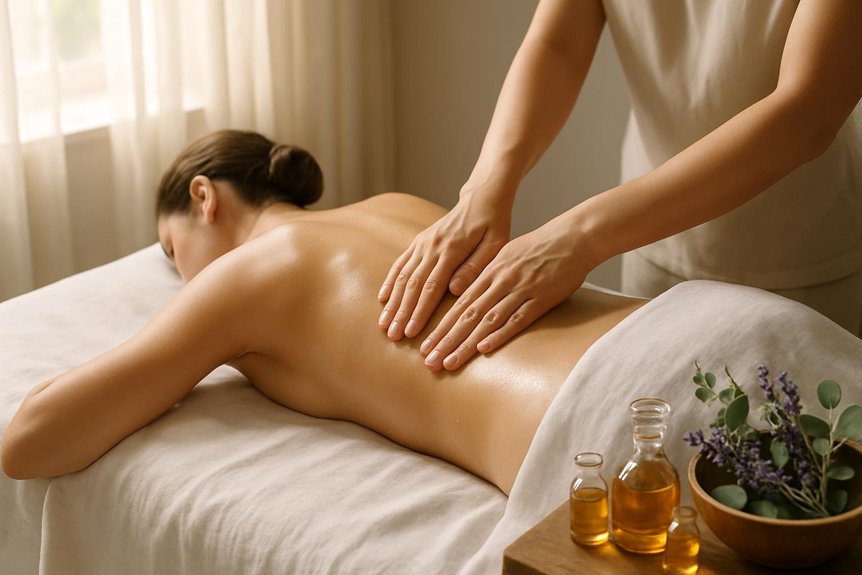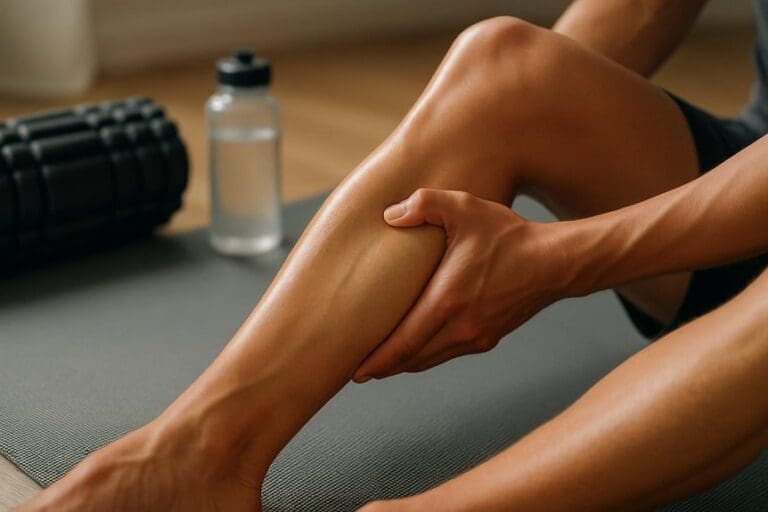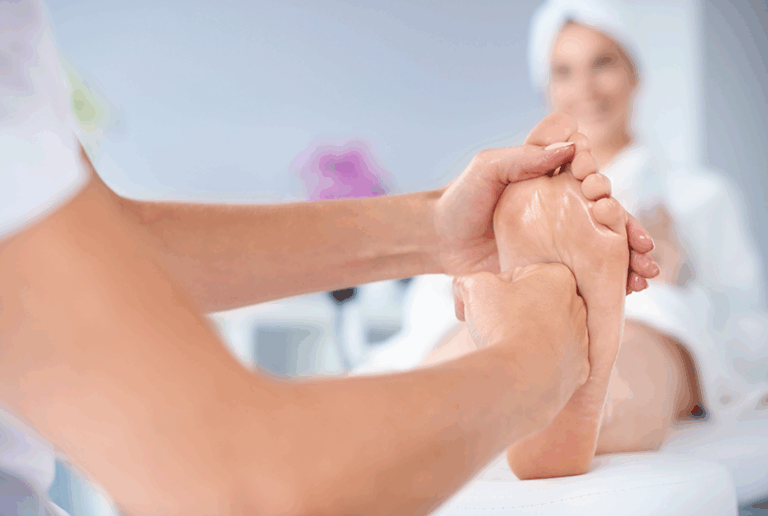Essential oil massage can reduce back pain via combined mechanical and neurochemical effects. Gentle myofascial work improves circulation and decreases muscle guarding, while essential oils (e.g., lavender, marjoram, peppermint, rosemary) modulate nociception, induce parasympathetic dominance, and reduce hyperalgesia. Slow rhythmic strokes enhance gate-control mechanisms. Oils are diluted safely (1–2%) with screening for contraindications. It suits stress-amplified or mechanical back pain, with aftercare including hydration, gentle mobility, and heat. Persistent or worsening symptoms warrant medical review. More practical specifics and safety details follow.
How Aromatic Massage Targets Back Pain Mechanisms
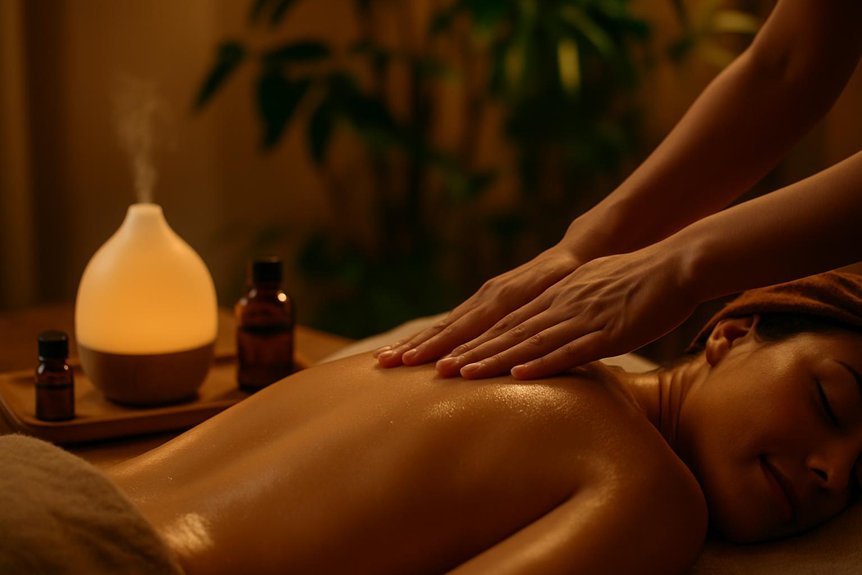
Aromatic massage addresses back pain via combined mechanical and neurochemical pathways: targeted soft-tissue manipulation reduces myofascial tension, improves local circulation, and modulates nociceptive input, while selected essential oils may influence pain signaling and autonomic tone through transdermal absorption and olfactory pathways. At Spa & Massage, therapists assess pain generators—paraspinal hypertonicity, trigger points, and dorsal fascial restrictions—then apply graded pressure, longitudinal strokes, and sustained myofascial release to normalise tone and restore glide. This downregulates spinal sensitisation and supports parasympathetic dominance, easing guarded breathing and sleep disruption linked to back pain. Blends are chosen after screening for sensitivities; dilution is calibrated for safety and absorption. Sessions are paced to the client’s breath, inviting quiet, attentive awareness that reinforces analgesia through reduced vigilance and improved interoceptive calm. Relaxation and pain relief are central to aromatherapy massage, making it a holistic option for individuals seeking natural back pain management.
Essential Oils Our Therapists Use for Back Discomfort
Building on the described neurochemical and mechanical pathways, the choice of oils becomes a targeted adjunct to manual therapy. At Spa & Massage, therapists select essential oils for their documented analgesic, anti-inflammatory, and anxiolytic properties, diluted in skin-safe carriers to ensure ideal dermal absorption and glide.
Lavender (linalool-rich) supports parasympathetic shift and reduces pain perception.
Sweet marjoram may ease muscle hypertonicity.
Peppermint (menthol) provides cooling counter-irritation, helpful over paraspinals after deep tissue work.
Rosemary cineole can enhance local circulation and perceived stiffness relief.
Frankincense may modulate discomfort through TRP-channel interactions and calm guarded breathing.
Ginger or black pepper introduce gentle warmth to tight quadratus lumborum or gluteals.
In clinic, blends are bespoke, concentrations remain within 1–3%, and contraindications—pregnancy, anticoagulants, dermatitis, asthma triggers—are screened before application.
What to Expect in an Aromatherapy Session for Back Pain
At Spa & Massage, an aromatherapy session for back pain begins with a brief clinical assessment to establish goals, contraindications, and pressure preferences.
Therapists then select and patch-test essential oils based on the client’s presentation, applying targeted techniques—such as myofascial release, effleurage, and focused trigger-point work—at a calibrated pressure.
The session concludes with evidence-based aftercare, including hydration guidance, gentle mobility work, and advice on heat application and symptom monitoring.
Personalised Assessment and Goals
How does a session begin when the goal is to reduce back pain with essential oil massage? At Spa & Massage, it starts with a concise, confidential assessment: onset, duration, aggravating and easing factors, prior imaging or diagnosis, sleep quality, stress load, and medication use.
Therapists screen for red flags and identify pain patterns—facet-related, myofascial trigger points, or postural strain—through palpation and simple range-of-motion checks.
Personal goals are then defined: pain reduction targets (e.g., VAS decrease), mobility gains (flexion/rotation), and functional aims such as sitting tolerance or ease on waking. Preferences for pressure, touch pace, and room ambience are noted to support nervous-system downregulation.
A session plan is documented: regional focus, technique sequencing, and dosage. Measurable outcomes guide progression, with re-assessment scheduled to verify effect and refine care.
Oils Selection and Testing
Following assessment, oil selection focuses on safety, analgesia, and autonomic calming. At Spa & Massage, therapists prioritise contraindications (pregnancy, allergies, asthma, anticoagulants), then choose dilutions consistent with clinical guidance—typically 1–2% essential oil in hypoallergenic carrier oils such as grapeseed or fractionated coconut.
For back pain, commonly considered options include lavender or bergamot (parasympathetic support), peppermint or eucalyptus (cooling counterirritant), and ginger or black pepper (warming vasodilatory effects). Selection is adjusted for sensitivity and medication interactions.
A patch test is performed on a small forearm area, observed for 10–15 minutes; any pruritus, erythema, or dizziness prompts reformulation.
Fragrance intensity is titrated to a gentle, intimate envelope rather than a strong perfume. Many clients at Spa & Massage prefer unscented bases when migraines or dermatitis are present.
Techniques, Pressure, Aftercare
While intake findings guide the plan, an aromatherapy back-pain session proceeds in a structured sequence: targeted effleurage warms tissues and spreads the selected blend, followed by slow petrissage and myofascial glide to reduce paraspinal tone. Then, focused trigger-point compression along the erector spinae, quadratus lumborum, and gluteal referral zones is performed.
Pressure is titrated from light-medium during oil application to moderate, sustained compression when taut bands are identified. The intensity is kept below a 6/10 discomfort threshold to prevent guarding. In our Spa & Massage clinics, therapists cue slow breathing, monitor skin response, and adjust cadence to match sensitivity.
Aftercare is deliberate: patients are advised to hydrate, apply gentle heat, and perform hour-later mobility drills (pelvic tilts, knee-to-chest). Our therapists recommend 24 hours of load modification and reassessment at the next visit.
Comparing Aromatic Massage With Deep Tissue and Sports Techniques
Essential oil massage typically uses lighter pressure, slower pacing, and a relaxation-focused intent.
Deep tissue and sports techniques employ higher pressure, targeted pacing, and corrective intent for specific myofascial restrictions.
Pain relief mechanisms differ: aromatherapy integrates cutaneous stimulation with olfactory-mediated autonomic modulation.
In contrast, deep tissue and sports approaches prioritize mechanotransduction, trigger point deactivation, and improved tissue glide.
At Spa & Massage, therapists match pressure, pace, and intent to the client’s goals—calming neurogenic pain and stress with aromatherapy or addressing localized dysfunction with deep tissue or sports methods.
Pressure, Pace, and Intent
How do pressure, pace, and therapeutic intent differentiate essential oil massage from deep tissue and sports techniques in clinical practice? It typically applies light-to-moderate, well-distributed pressure with a slower, rhythmic pace to modulate autonomic arousal and support parasympathetic dominance. The intent is integrative: reduce guarding, ease myofascial tone, and enhance comfort via olfactory-mediated relaxation.
Deep tissue and sports techniques prioritise targeted, higher-pressure loading, slower stroke speed over shortened tissues, and precise friction or stripping to address adhesions and functional limitations.
At Spa & Massage, therapists calibrate pressure using client-led feedback and palpatory findings. For back pain with heightened sensitivity or stress, they privilege aromatherapy pacing and essential oil blends selected for tolerability and soothing scent. When restricted segments persist, they layer focused deep tissue or sports methods briefly, preserving therapeutic safety and intimacy.
Pain Relief Mechanisms
Because nociception, autonomic tone, and muscle loading interact, pain relief arises through distinct but complementary pathways across massage styles.
This massage moderates sympathetic drive and dampens central sensitisation via slow, rhythmic strokes and inhaled essential oils. In our clinics, therapists select lavender or sweet marjoram to promote parasympathetic dominance and reduce hyperalgesia.
Deep tissue techniques target myofascial adhesions and trigger points, improving tissue glide, perfusion, and mechanoreceptor input that downregulates pain via gate-control.
Sports massage adds graded loading, neuromuscular techniques, and stretching to normalise tone, restore range, and reduce nociceptive input from fatigued or overloaded segments.
Spa & Massage integrates these mechanisms, sequencing relaxation-led aromatherapy to soften guarding, then focused deep tissue or sports methods where indicated.
Clients receive tailored pressure, paced breathing, and precise aftercare to sustain relief.
Safety, Contraindications, and Who Benefits Most
For individuals with back pain, essential oil massage is generally safe when delivered by trained therapists using appropriate dilutions and screening.
At Spa & Massage, therapists review medical history, medications, allergies, pregnancy status, and skin integrity, then select gentle concentrations (typically 1–2%) and non-sensitising carrier oils. Patch testing is used when sensitivity is suspected.
Contraindications include active skin infections, open wounds, recent fractures, acute thrombosis, uncontrolled hypertension, fever, or severe osteoporosis.
Caution and medical clearance are advised for cancer therapy, anticoagulants, epilepsy (with specific oils), asthma, and first-trimester pregnancy.
Citrus oils may increase photosensitivity; known allergens are avoided.
Those who benefit most include clients with mechanical low back pain, muscle tension, stress-related pain amplification, and sleep disturbance.
Spa & Massage tailors touch pressure, positioning, and oil profiles to these presentations.
At-Home Aftercare and When to Book With Spa & Massage
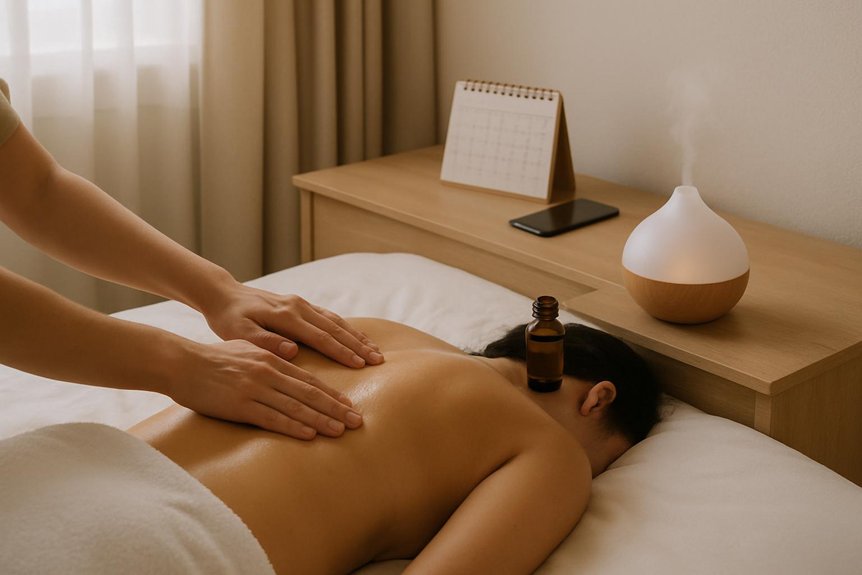
After an aromatic massage for back pain, at-home care should prioritise hydration, gentle mobility, and symptom monitoring to consolidate gains. Evidence supports drinking water, a brief warm shower, and light stretching of hips, hamstrings, and thoracolumbar fascia within pain-free limits.
In our clinics, therapists recommend diaphragmatic breathing, heat for stiffness, ice for acute flare-ups, and sleep hygiene to reduce nociceptive load.
Avoid heavy lifting for 24 hours; resume graded activity the next day.
Book with Spa & Massage when pain persists beyond 72 hours, sleep is disrupted, or stiffness limits daily function.
New radicular symptoms, fever, trauma, or progressive weakness warrant medical assessment before massage.
Many clients benefit from a series: weekly for 2–3 weeks, then tapering.
Locations across London offer consistent, personalised aromatherapy protocols.
Conclusion
In sum, aromatic massage can ease muscular tension, can lower stress-related pain perception, and can support sleep—benefits shown in small trials and consistent with clinical experience. It does not replace targeted deep tissue or sports work for acute injury, but it can complement them, can enhance recovery, and can improve adherence to self-care. With appropriate oil selection, clear goals, and safety screening, clients can expect measurable comfort, modest functional gains, and guidance on when to escalate care.
